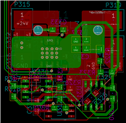Other Parts Discussed in Thread: LM3409
Hi!
I try to get a variable output voltage for LEDs (0A..1A2). I did not choose the LM3409, because: It use a diode (D1 on the first page of the datasheet) instead of a FET for the current from ground to the coil...
Therefore I use an opamp (see appendix),
- whose output is connected to VSENSE,
- whose positive input is connected to a voltage divider that is connected to a low side current sense resistor (4mR) and a DAC output (0V..2V4), and
- whose negative input is connected to a voltage divider (1kR/100kR) that is connected to ground and the output of the opamp.
it works quite good until the output current reaches about 50%. Above 50% the output current is oscillating between 0% and 50% at about 2Hz.
It seems to get better with a 5R resistor instead of the 12V LED.
Furthermore a higher frequency (e. g. 350kHz instead of 114kHz) and a higher C4 (300nF instead of 100nF) seem to help (but i m afraid that the postal radio frequency inspectors go postal, when I do that all day).
Why is that?
How can i fix my design?
Thx.
Bye
Arne




